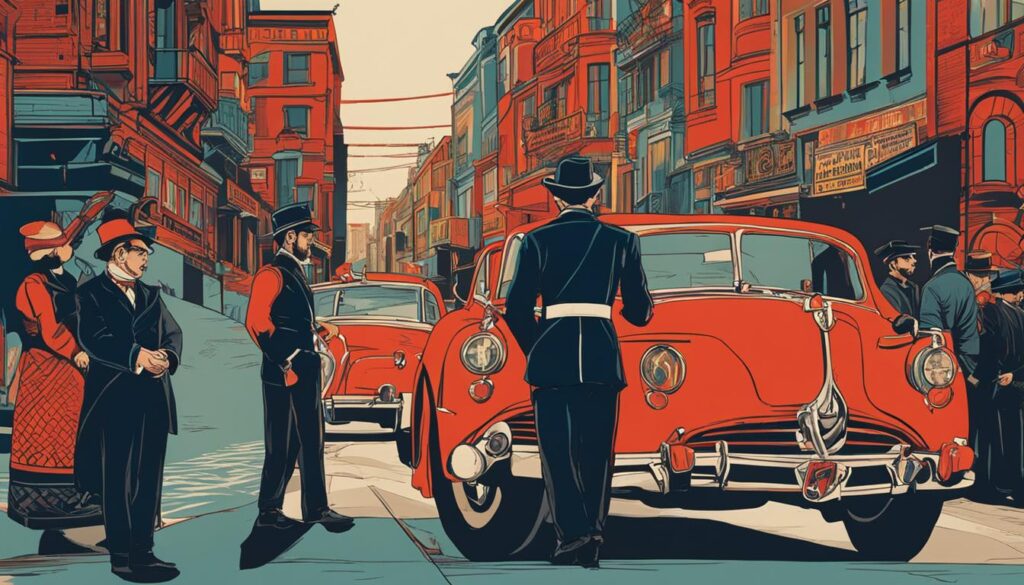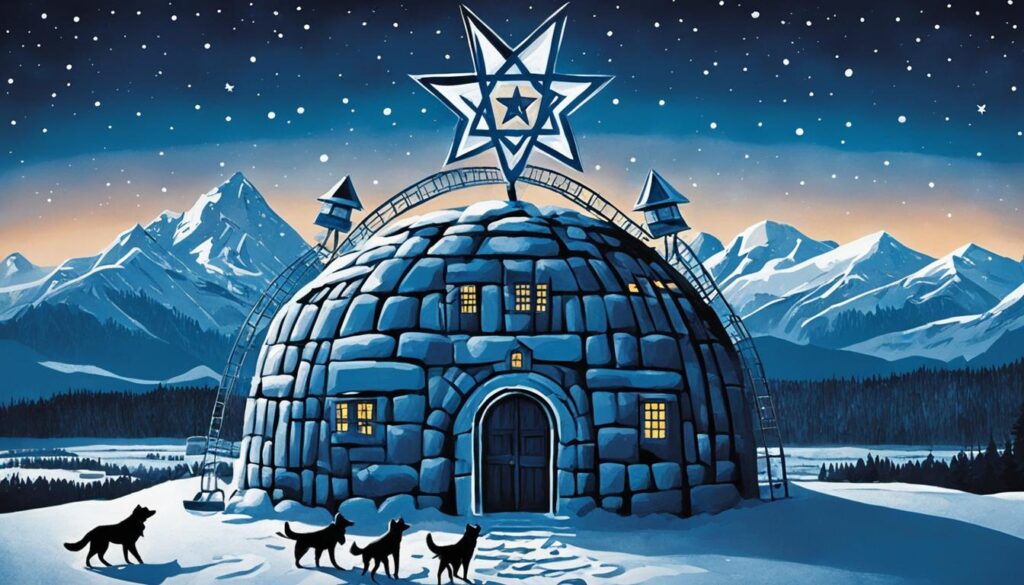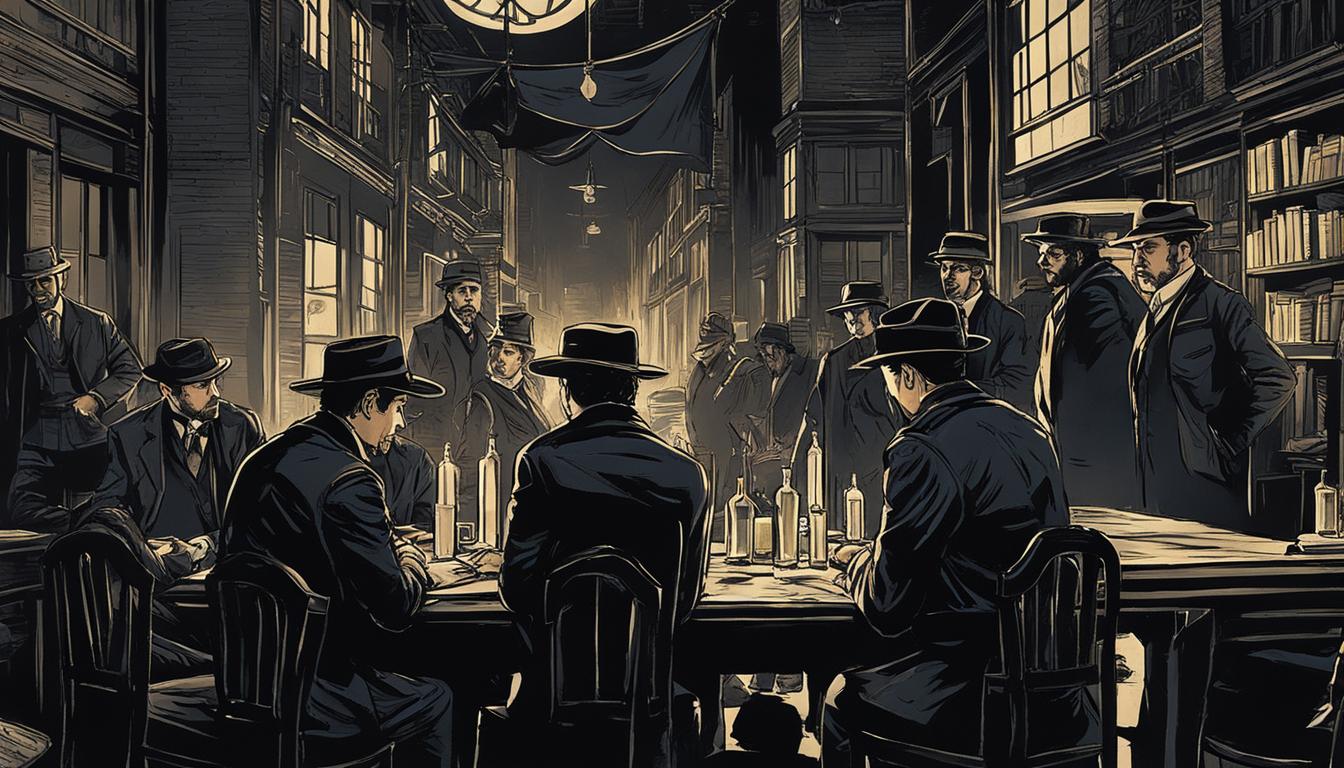Delving into the intricate world of alternative history novel and detective fiction, Michael Chabon’s The Yiddish Policemen’s Union stands as a novel that transcends genres to offer a vivid tableau of speculative storytelling. This The Yiddish Policemen’s Union review explores the nuances of Chabon’s magnum opus that has garnered critical acclaim and captured the imaginations of readers worldwide.
Rife with suspense and laced with the author’s characteristic literary panache, Michael Chabon’s vision navigates through an impeccably constructed alternate reality. Here, the Jewish diaspora found a temporary sanctuary in Sitka, Alaska, after World War II, setting the stage for a compelling detective story that questions identity, belonging, and the often blurred line between past and present.
This introduction serves as a gateway to understanding Chabon’s unique position within contemporary literature, establishing the groundwork for a deeper investigation into the themes, characters, and stylistic mastery that define The Yiddish Policemen’s Union. Join us as we unravel the layers of one of the most intriguing works in Michael Chabon’s repertoire, ensnaring readers in its narrative web.
Introducing “The Yiddish Policemen’s Union”: A Unique Alternative History Novel
When it comes to Michael Chabon’s literature, “The Yiddish Policemen’s Union” stands out as a remarkable foray into the realms of alternative history and speculative fiction. This detective novel pushes the boundaries of imagination, propelling readers into a world where historical outcomes veer off into unexpected directions. Chabon envisages an alternate reality in which Jewish refugees find sanctuary in Sitka, Alaska, creating a rich backdrop that combines fact with speculation in this genre-bending narrative.
Chabon’s intricate universe in “The Yiddish Policemen’s Union” is not merely an alternative timeline for the sake of deviation but is suffused with keen insights into identity and belonging. As the crux of the narrative, Sitka epitomizes the complexities of a refuge shaped by those who have encountered systemic displacement yet look to forge a semblance of home. The result is a detective story bolstered by the depth of its setting, where the plot is as much about unraveling a mystery as it is about dismantling the layers of Chabon’s meticulously constructed world.
By interlacing the meticulousness of a detective narrative with the broader societal fabric of Sitka, Chabon achieves a dynamism often sought after in detective fiction – a story that is boundless in its intrigue and profound in its exploration of humanity.
This novel is not just a detective’s journey through the tendrils of a tightly-packed mystery; it is an exploration into the soul of an eclectic society imagined by Chabon. Here readers are not just uncovering the clues of a convoluted case but navigating through the dense fog that is the essence of an alternate history.
- The Premise: Alternative history as the narrative’s cornerstone
- Historical Divergence: Weaving fact with Chabon’s fiction
- Genre Fusion: Blending detective narrative with speculative creativity
- First Impressions: Setting up the intrigue within a reimagined world
The pages of “The Yiddish Policemen’s Union” are imbued with the brusque lifeblood of Chabon’s alternative vision, offering a tapestry of themes that make for a reading course as rich and as satisfying as the genre itself promises. It is in this union of history and imagination, anchored by a detective tale, that readers find themselves not just observers, but participants in a world that could have been.
The Alt-History of Sitka, Alaska: Setting the Scene for Chabon’s Detective Tale
In Michael Chabon’s “The Yiddish Policemen’s Union,” an intriguing Sitka Alternative history establishes more than just a backdrop for a gripping detective tale; it constructs a realm where Jewish fiction and world-building converge to reveal a society riddled with complexity and conflict. As readers traverse this unprecedented Yiddish settlement in Alaska, they encounter a vibrant yet turbulent world that crucially molds the story’s essence.
Imagining a Temporary Jewish Refuge
The vision of Sitka as a temporary sanctuary is a cornerstone in Chabon’s alternative world. The city bears the marks of Jewish traditions and historical echoes, blending them seamlessly with the fabric of the Alaskan wilderness. Addressing themes of displacement and belonging, Chabon enriches the Jewish fiction landscape with a mesmerizing blend of imagination and historical grounding.
The Importance of Setting in Chabon’s Narrative
Sitka’s portrayal as a living, breathing community is not merely a setting but an active participant in the storytelling. Through nuanced world-building, Chabon positions the locale at the core of numerous narrative threads — each thread pulling at the tensions of identity, faith, and impermanence.
Let us delve into the intricacies of Sitka’s societal dynamics through a detailed comparison:
| Aspect of Sitka | Role in World-Building | Impact on Narrative |
|---|---|---|
| Cultural Landscape | Reflects a unique fusion of Yiddish and Alaskan influences | Offers a rich setting for intersecting personal and political plots |
| Political Climate | Highlights the temporariness and instability of the refuge | Drives the urgency behind the detective tale’s unfolding events |
| Social Fabric | Showcases a range of responses to the transitory nature of home | Facilitates character development and thematic exploration |
| Geographic Isolation | Encapsulates the community, enhancing its insular feel | Fosters a sense of claustrophobia and tension pivotal for the genre |
By intricately designing an alternative history where Jewish culture permeates the cold expanse of Alaska, Chabon not only crafts an enthralling world but also shapes a resonant, poignant reflection of the human experience. This setting, with its myriad implications, propels the detective narrative into a realm of substantial thematic depth and captivating imagination.
Evaluating Michael Chabon’s Literary Craftsmanship
Unveiling the layers of Michael Chabon’s writing reveals a narrative style steeped in authenticity and rich literary technique. His ability to capture the essence of a moment and the nuances of character emotion sets his work apart. A key aspect of Chabon’s storytelling mastery is his use of the Yiddish dialect, an element that infuses his narratives with a sense of history and cultural identity.
Chabon’s Distinctive Narrative Voice
The narrative voice in Chabon’s works is instantly recognizable, weaving complex characters and intricate plots with a lyricism that is distinctly his own. This signature approach not only captivates readers but also builds a deeply immersive world that resonates with a broad audience. Chabon’s dexterity in narrative style allows for a storytelling that is both grand in scope and intimate in detail.
Dialogue and Dialect: The Use of Yiddish
Dialogue and dialect play a central role in bringing Chabon’s characters to life. His strategic use of Yiddish phrases adds layers of meaning and enhances the authenticity of the setting. Whether through subtle idioms or overt expressions, Chabon’s characters speak in a manner that richly paints their cultural backdrop, while also emphasizing their emotional journeys and relational dynamics.

Characters and Complexity in “The Yiddish Policemen’s Union”
Deep within the heart of Michael Chabon’s vividly imagined world lies a cast of characters whose emotional landscapes are as intricate as the book’s alternate history setting. At the forefront of this character ensemble is Detective Meyer Landsman, a figure whose personal journey of redemption and discovery is as compelling as the novel’s overarching mystery.
Protagonist Detective Meyer Landsman
The character of Meyer Landsman stands as a testament to Chabon’s skill in character development. The detective’s rich backstory and internal struggles allow readers to engage with him as a literary character that is both flawed and relatable. His complex relationships and dogged pursuit of justice drive the narrative forward and showcase Chabon’s ability to blend genre tropes with deep character exploration.
Supporting Cast: The Depth of Chabon’s Characters
The narrative’s depth is further enriched by a supporting cast that each brings their own idiosyncrasies and histories to the page. These figures, from the tenacious Berko Shemets to the enigmatic and alluring Ester-Malka, present a tableau of personalities that illuminate the diverse spectrum of life in Chabon’s alternative Sitka. Their interactions with Landsman provide a textured backdrop against which the themes of alienation, community, and identity play out.
Chabon’s mastery in creating multi-dimensional characters extends beyond just the leads. Even those playing smaller roles add layers to the novel’s exploration of community, faith, and the human condition. Collectively, they populate a world that feels at once familiar and intriguingly unique, securing The Yiddish Policemen’s Union a place amongst the most memorable works of speculative fiction.
Plot Twists and Murder Mystery Elements
The labyrinthine heart of this noir fiction is a murder mystery that not only ensnares the reader with its clever plot twists but also pulls them into a mire of political intrigue. As the quintessential elements of noir are woven through the narrative, the reader is plunged into a world where the stark light of investigation casts long shadows over the political landscape, revealing that in noir, the line between the personal and the political is often blurred.
In the landscape of alternative history fiction, the crime at the core of the novel is not merely a narrative device but a keystone that supports an intricate archway of plot lines and thematic explorations. These elements combine to form a tale that both honors and reinvents the genre, ushering the traditional murder mystery into a realm replete with complexities and unexpected turns.
Combining Noir with a Politically Charged Plot
The narrative deftly navigates through the entangled skein of a murder investigation amidst the political machinations of an imagined society. This masterful fusion draws readers into a tapestry rich with intrigue, where the stakes extend far beyond the immediate whodunit to implicate broader societal issues and existential quandaries.
The Ingenuity of the Murder Investigation
Through meticulous crafting, the unraveling of this murder mystery unspools like a cinematic thriller, brimming with tension and punctuated by plot twists that compel the audience’s rapt attention. Each revelation is a thread pulled, subtly disturbing the weave of the established order, leading to a denouement that is as intellectually satisfying as it is emotionally resonant.
| Traditional Noir Element | Adaptation in Political Narrative |
|---|---|
| The Flawed Protagonist | Protagonist’s personal flaws intertwined with political allegiances |
| Gritty Urban Setting | Alternative history backdrop influencing societal dynamics |
| Mystery and Investigation | Case becomes allegory for larger political ramifications |
| Femme Fatale and Deception | Characters’ allegiances represent ideological complexities |
| The Underbelly of Society | Examination of marginalized communities within the political schema |
Themes Explored in “The Yiddish Policemen’s Union”
The rich tapestry of themes in literature provides a portal for readers to access the nuanced discussions of human experience, often encapsulating elements of exile, the notion of homeland, and intricacies of cultural identity. Michael Chabon’s “The Yiddish Policemen’s Union” is a profound exploration of these themes, interwoven with Jewish themes that present a compelling narrative imbued with cultural and religious commentary.
Ideas of Exile and Homeland
Chabon’s narrative delves deeply into the sentiment of exile, not just as a physical displacement but also as an existential quandary. The characters in the novel grapple with the loss of a homeland and the ceaseless search for belonging amidst the backdrop of an alternative history. This theme resonates sharply, inviting readers to reflect on their own understandings of place and identity.
Religion, Identity, and Cultural Commentary
Within the framework of Chabon’s alternative reality, the intertwining of religion and cultural identity emerges as a potent force shaping the lives and destinies of the characters. The novel does not shy away from probing questions of societal norms and beliefs, turning a discerning eye towards the constructs that define individual and collective identity.
Chabon’s deft handling of these themes echoes the broader dialogues of Jewish literature and thought, crafting a narrative that is at once specific in its cultural context yet universal in its exploration of the human condition.

Audiobook Review: The Spoken Word Experience of “The Yiddish Policemen’s Union”
Embarking on the audiobook journey of Michael Chabon’s “The Yiddish Policemen’s Union”, listeners are immediately met with a soundscape that envelops them into the heart of the narrative. This section examines the narration quality and vocal performance that collectively contribute to the overall audiobook experience. Accessibility and the ease of diving into Chabon’s world through audio form play a pivotal role in this exploration.
Narration Style and Vocal Performance
The vocal performance in the audiobook review of this novel is nothing short of transformative. The nuanced narration quality of the reader guides us through Chabon’s meticulously crafted detective world. Character voices are distinct and well-executed, while the use of dialects adds depth, bringing the multicultural landscape of Sitka, Alaska, vividly to life. Pauses, intonations, and pacing not only elevate the text but also allow the listener to grasp the subtleties and undertones present in the richly described settings and dialogues.
The Impact of Audio on Chabon’s World
The audiobook experience distinctly shapes the reception of Chabon’s world. With the voice acting serving as a lens through which we perceive character development and thematic delivery, each listener’s imaginations are uniquely stoked, highlighting the symbiotic relationship between written word and spoken performance. The ability to convey Sitka’s atmospheric tension through audio cues provides an immersive experience that may differ from, yet is just as profound as, the traditional reading journey.
The rhythm and cadence of the narrator’s delivery in “The Yiddish Policemen’s Union” audiobook creates an intimate connection with Chabon’s writing, transforming the abstract into the tangible, and inviting listeners to inhabit the space within the story.
Below is a table detailing aspects of the audiobook’s narration and its impact on the storytelling:
| Feature | Description | Impact on Story |
|---|---|---|
| Character Voices | Distinct, well-crafted with attention to accents and mannerisms | Deepens the connection to characters, enriching the narrative |
| Narration Pace | Considered and dynamic, matching the story’s ebb and flow | Enhances suspense and allows for reflective pauses in the plot |
| Emotional Delivery | Expressive, conveying the mood of scenes effectively | Evokes empathy and aligns the listener’s emotional response with character arcs |
| Use of Dialect | Authentic, consistent use of Yiddish influences | Adds cultural authenticity and depth to the setting |
Conclusively, the vocal performance in the audiobook of “The Yiddish Policemen’s Union” carries an intrinsic value that cannot be understated. It shapes the contours of the alternative reality Chabon presents, fortifying the listener’s audiobook experience in ways only the power of voice can achieve.
Critical Reception and Awards
The literary world has warmly received The Yiddish Policemen’s Union, acknowledging Michael Chabon’s ingenuity with numerous literary awards and critical accolades. This section delves into the novel’s commendation by the literary community and examines how reader reception and book reviews reflect its impact and standing amongst contemporary works of fiction.
Recognition in the Literary Community
Michael Chabon’s The Yiddish Policemen’s Union has been celebrated for its originality and narrative flair, as evidenced by its reception of prestigious awards, including the esteemed Hugo Award for Best Novel and the Nebula Award for Best Novel, solidifying its reputation within the genres of science fiction and detective fiction. Here we chart the novel’s triumph in the landscape of literary awards.
Examining Reviews and Audience Reception
From professional critics to casual readers, the acclaim for The Yiddish Policemen’s Union is echoed in book reviews and reader responses alike. The reader reception has been overwhelmingly positive, with particular praise for the novel’s intricate plot and innovative blend of cultural elements. Literary forums and reading hubs are replete with discussions and analyses that underscore the work’s lasting legacy.
| Award | Year | Category | Result |
|---|---|---|---|
| Hugo Award | 2008 | Best Novel | Winner |
| Nebula Award | 2007 | Best Novel | Winner |
| Locus Award | 2008 | Best SF Novel | Finalist |
| Sidewise Award for Alternate History | 2007 | Long Form | Finalist |
| Edgar Award | 2008 | Best Novel | Nominee |
Conclusion
As we encapsulate the essence and stature of “The Yiddish Policemen’s Union” against the backdrop of Michael Chabon’s illustrious career, it is apparent that this piece stands as a testament to his ability to cross genre boundaries. Tackling alternative history with a deft hand, Chabon infuses his detective fiction with rich cultural tableau and intricate human complexities, offering a narrative that is as thought-provoking as it is entertaining. Reflecting on literature and the power it holds to both illuminate and imagine, Chabon’s work strengthens with this ambitious and textured novel.
Reflecting on Chabon’s Work Within His Literary Oeuvre
In the panorama of Chabon’s work, “The Yiddish Policemen’s Union” emerges as a crucial junction of literary analysis and storytelling prowess. It interweaves the tribulations and triumphs of an alternate Jewish homeland with the personal odyssey of its characters, particularly the endearingly flawed Meyer Landsman. This integration of personal sagas and sweeping historical canvases accentuates Chabon’s propensity for composing narratives that leave an indelible mark on the literary landscape.
Should You Dive Into “The Yiddish Policemen’s Union”?
Considering the intellectual journey and the myriad of human experiences presented in the book, any recommendation would affirm the novel’s merit for readers who appreciate layered plots and profound thematic developments. Encountering Chabon’s novel, whether through the intimacy of the printed word or the dynamic storytelling of an audiobook, promises a voyage into a space where history’s shadow and the human condition collide and coalesce. For enthusiasts yearning to explore the depths of a meticulously crafted world, “The Yiddish Policemen’s Union” should certainly find its way onto your bookshelf or digital library. A book recommendation, in this case, serves not just as a suggestion, but as an invitation into the remarkable synergy of imagination and reality brought forth by Michael Chabon’s sheer narrative invention.



